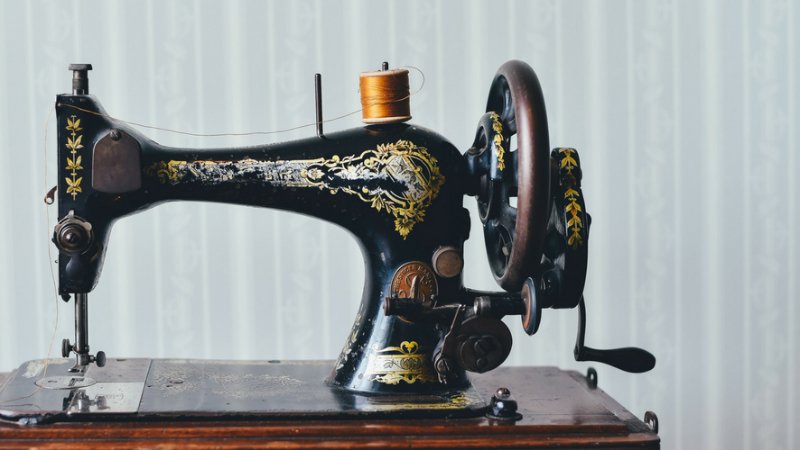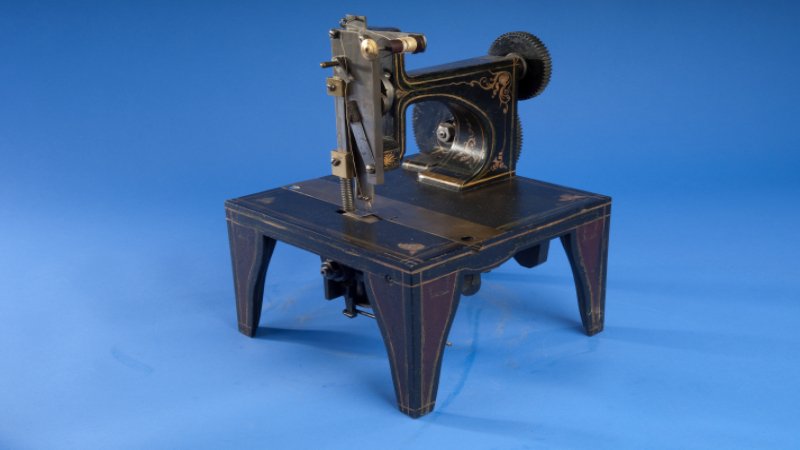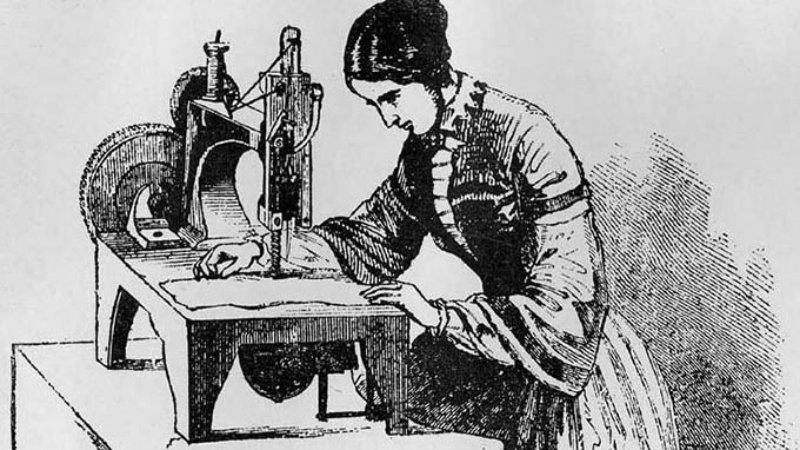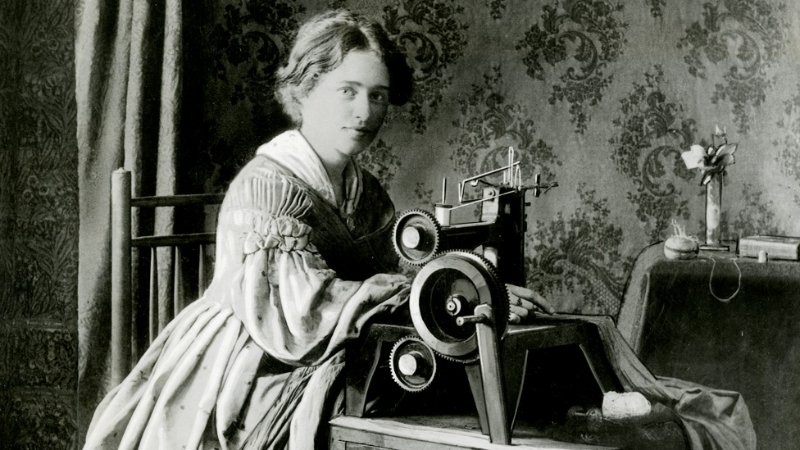Sewing Machine Invention: How it Revolutionized Fashion and Industry
Imagine a world without mass-produced clothing. Today, we are surrounded by readily available fashion, but the technology that made this possible is often taken for granted. This article delves into the fascinating history of the sewing machine, a seemingly simple invention with a complex past and profound impact. By exploring its origins, you’ll gain a deeper appreciation for the ingenuity of its inventors, understand its crucial role in shaping the modern garment industry and even society, and connect with the very roots of how our clothes are made. Let’s read!
1. From Hand to Machine: The Genesis of Sewing
1.1 Ancient Roots of Sewing
The story of sewing begins not in factories, but in ancient times. For tens of thousands of years, humans have needed clothing for protection and warmth, and the earliest forms of sewing emerged from this fundamental need. Imagine early artisans meticulously crafting early needles from bone or horn and using materials like animal sinew thread to join pieces of fabric or animal hides.
This labor-intensive sewing was incredibly time-consuming. Every garment, from the simplest tunic to more elaborate coverings, represented countless hours of painstaking work. In this pre-industrial clothing production, clothing was a precious commodity, reflecting the immense effort required to create it.

1.2 The Dawn of Mechanization: The First Industrial Revolution
The world began to change dramatically with the First Industrial Revolution (roughly 1760-1840), primarily in Great Britain. This era marked a profound shift from manual labor to machine production. The textile industry stood at the forefront of this transformation. Suddenly, there was a growing demand for faster, more efficient ways to produce textiles. Societal and economic pressures were mounting; the existing methods of hand production simply couldn’t keep pace with the burgeoning populations and new markets.
This period of technological advancements spurred a race to innovate and find mechanical solutions for age-old crafts, including the crucial task of sewing. The stage was set for the mechanization of sewing and the birth of the Industrial Revolution sewing machine, a revolutionary invention that would forever alter the landscape of clothing production.
2. Early Attempts: Seeds of Innovation
2.1 Charles Weisenthal (1755): The Hint of a Machine
The first glimpse of mechanized sewing can be traced back to Charles Weisenthal and his 1755 patent in Britain. While the patent itself doesn’t describe a complete sewing machine, it details a needle “designed for a machine.”
This machine needle patent, though seemingly simple, is significant. It suggests that the concept of mechanical sewing was beginning to take shape in people’s minds. Weisenthal’s early sewing needle design serves as a sewing machine precursor, a subtle but important indication that innovation was stirring in the realm of garment making.
2.2 Thomas Saint (1790): Leather and Canvas Pioneer
A more concrete step towards the sewing machine emerged with Thomas Saint in 1790. Saint designed and patented a machine specifically intended for working with leather and canvas. This 1790 sewing machine was envisioned as a leather sewing machine and canvas sewing machine, materials known for their robustness and difficulty to sew by hand. Saint’s machine was hand crank sewing machine operated, and while no physical machine from his time survives, detailed patent drawings were rediscovered in 1874.
Intriguingly, a working replica of Saint’s machine was later constructed based on these drawings, proving the viability of his design. Saint’s early sewing machine patent represents a significant leap forward, showcasing a clear mechanical concept for automating the process of sewing, particularly for heavy-duty materials.
3. The 19th Century: A Flurry of Sewing Machine Inventions
3.1 Balthasar Krems (1810): Caps and Needle Innovation
Among these early innovators was Balthasar Krems, who in 1810, designed a machine specifically for cap sewing machine. Krems’s key contribution was a seemingly small but incredibly significant needle innovation: placing the needle eye at the point. This seemingly simple change was a crucial element adopted in many later successful designs, as it allowed for a more efficient and reliable stitch formation.
Despite the importance of Krems’s needle innovation, his 1810 sewing machine was never patented. As an unpatented invention, Krems’s work remained less widely known during his time, but its influence on subsequent developments is undeniable.

3.2 Josef Madersperger (1814): “The Sewing Hand” Rejected
In Austria, Josef Madersperger received a patent in 1814 for his invention, dubbed “the sewing hand”. This Austrian sewing machine, described as mimicking the motions of hand sewing, was an intriguing concept. However, Madersperger’s 1814 patent and his invention faced significant hurdles. He suffered from lack of funding for inventors, hindering his ability to refine and market his machine.
Furthermore, societal technophobia, a fear of new technologies, may have contributed to the lukewarm reception of his invention. Despite being an early sewing machine patent, Madersperger’s “sewing hand” ultimately did not achieve commercial success, highlighting the challenges early inventors faced beyond just technical ingenuity.
3.3 John Knowles and Reverend John Adams Dodge (1818): American Pioneers (and Failures)
Across the Atlantic, John Knowles and Reverend John Adams Dodge created the first American sewing machine in 1818. This 1818 American sewing machine holds the distinction of being an early American invention in this field. However, despite their pioneering status, their machine was a practical failure.
It was reported to have broken down after sewing only a few seams, demonstrating the significant engineering challenges still to be overcome. This failed sewing machine design, while not commercially viable, represents an important step in the overall learning process, illustrating that even imperfect attempts contributed to the eventual success of the sewing machine.
3.4 Barthélemy Thimonnier (1830): Chain Stitch and Factory Fate
A more impactful, albeit tragically short-lived, venture came from Barthélemy Thimonnier in France. In 1830, Thimonnier invented a wooden sewing machine that utilized a hooked needle to create a chain stitch. Unlike previous inventors, Thimonnier was also an entrepreneur.
He boldly opened the first clothing factory using his machines to produce army uniforms. This marked a significant step towards industrializing garment production. However, Thimonnier’s success was met with fierce resistance.
Tailors, job displacement fears and fueled by social resistance to technology, tragically burned down his factory. This devastating event underscores the social and economic anxieties that accompanied automation and the disruption of traditional crafts, even as it showcased the potential of Thimonnier’s 1830 sewing machine.

3.5 Walter Hunt (1834): Lockstitch, but No Patent (Moral Dilemma?)
Another pivotal invention emerged in America in 1834, courtesy of Walter Hunt. Hunt developed a lockstitch mechanism, a significant improvement over the chain stitch. His 1834 sewing machine employed a two-thread sewing machine technique, creating a more secure and durable stitch. Hunt’s lockstitch invention was a major technical advancement.
However, Hunt made a surprising decision: he chose not to patent his invention. His ethical concerns of invention stemmed from a moral dilemma. Hunt worried about the potential job displacement concerns for seamstresses if his machine became widely adopted. This fascinating episode highlights the inventor’s moral dilemma and the complex social impact of technology, even for inventions with transformative potential.
4. The Breakthrough: Howe and Singer and the Sewing Machine Revolution
4.1 Elias Howe (1846): The Patented Lockstitch and Legal Battles
Elias Howe secured a crucial Elias Howe patent in 1846 for his refined lockstitch sewing machine. His 1846 patent detailed several key sewing machine features that made his design stand out. Crucially, Howe’s machine incorporated a needle with the needle eye at point, working in conjunction with a shuttle mechanism positioned beneath the fabric to create the secure and efficient lockstitch.
Furthermore, his design included an automatic feed mechanism, which moved the fabric along automatically, ensuring consistent stitch length and freeing the operator from manually advancing the material.
Despite this groundbreaking invention, Howe initially struggled to find financial backing in America. He even spent time in England trying to secure funding. Upon his return to America, Howe discovered that his invention was being widely copied by other manufacturers.
This led to a protracted and significant Howe’s patent lawsuit, a landmark patent infringement case where Howe fought to protect his intellectual property and gain recognition for his invention. Ultimately, Howe won the lawsuit, securing his right to sewing machine royalties and solidifying his place in sewing machine history.
4.2 Isaac Singer (1851): Modern Design and Mass Appeal
Isaac Singer entered the scene in 1851 and made further critical contributions, developing what is considered the first version of the modern sewing machine design. Singer’s 1851 sewing machine incorporated several key Singer’s improvements that enhanced usability and practicality.
Perhaps most notably, Singer introduced the foot pedal sewing machine, which freed up both hands of the operator to manipulate the fabric, significantly improving control and efficiency. He also oriented the needle to move in an up-and-down needle motion, a more efficient and reliable action compared to earlier designs.
While Singer built upon the work of predecessors like Howe, Hunt, and Thimonnier, he ingeniously combined and refined their elements into a more cohesive and user-friendly machine. Beyond the technical improvements, Singer was a marketing genius.
He understood the importance of making sewing machines accessible and appealing to a wider audience. Through innovative sewing machine marketing strategies, including hire-purchase plans, Singer transformed the sewing machine into a mass market product.
His company achieved phenomenal commercial success of sewing machine, dominating the market. However, Singer’s success also led to legal challenges, including the Howe vs. Singer lawsuit, where Howe successfully sued Singer for patent infringement, further solidifying the importance of Howe’s original lockstitch patent.
5. Patent Wars and the Sewing Machine Combination
5.1 Patent Infringement and Legal Battles
The most prominent of these legal clashes was the Howe vs. Singer lawsuit. Elias Howe, having secured his lockstitch patent, felt compelled to defend his intellectual property against those who were profiting from his invention without proper authorization.
He initiated a patent infringement case against Isaac Singer, arguing that Singer’s successful machines were utilizing the core principles of his patented lockstitch mechanism. This legal battle over sewing machine patent became a landmark case, with significant implications for patent law and the burgeoning industrial landscape.
In 1854, the court reached a 1854 court decision in Howe’s favor. Singer’s defense attempted to argue that Walter Hunt’s design in lawsuit, specifically Hunt’s earlier lockstitch invention, predated Howe’s and therefore invalidated Howe’s patent. However, the court rejected this argument, recognizing Howe’s patent as valid and enforceable, thus solidifying sewing machine patent rights and establishing Howe’s claim to royalties.

5.2 The Sewing Machine Combination (1856-1877): Cooperation and Control
In a surprising move to end the costly and disruptive patent wars, the major sewing machine manufacturers decided to collaborate. In 1856, the Sewing Machine Combination, sometimes referred to as the Sewing Machine Trust, was formed. This groundbreaking patent pool brought together key players in the industry, including Singer, Howe, Wheeler & Wilson, Grover & Baker and others.
The core of the 1856 patent agreement was the pooling of their key patents. Under this agreement, each company gained the right to use the patented technologies of the others, effectively cross-licensing their inventions.
A crucial element of the Combination was the agreement on sewing machine royalties. Every company manufacturing sewing machines in the US was obligated to pay Howe a royalty of $5 per machine, and $1 per machine exported. The Sewing Machine Combination had a significant impact on sewing machine market stability.
By controlling the patents, they effectively controlled competition and stabilized prices within the industry. This period of industry cooperation lasted until 1877, when the original patents began to expire, marking the end of the Combination’s direct control, but its legacy of patent pooling and industry consolidation remained influential.
6. From Factories to Homes: The Sewing Machine’s Expanding Reach
6.1 Market Expansion and Consumer Adoption (1860s Onward)
Starting in the 1860s and continuing onward, consumer sewing machines became increasingly affordable and readily available. Clever marketing strategies, like installment payment plans pioneered by Singer, made these once-expensive machines accessible to a broader segment of the population.
This home sewing machine market growth signified a major shift. Sewing was no longer solely confined to factories and professional tailors; it was rapidly becoming a common household practice.
The social impact of sewing machine adoption in homes was profound. It significantly impacted women and sewing machines, providing new skills and opportunities within the domestic sphere. Home dressmaking flourished, allowing families to create and customize their own clothing, leading to greater fashion autonomy and creativity.
The fashion changes due to sewing machine were also noticeable with new styles and designs becoming more easily produced and disseminated, contributing to a more dynamic and accessible fashion landscape.
6.2 Electric and Electronic Innovations (Late 19th and 20th Centuries)
A further leap in sewing machine technology came with the advent of electricity. In 1889, Singer introduced the first electric sewing machine (Singer 1889) for home use. This innovation liberated users from hand cranks and foot treadles, making sewing smoother, faster, and less physically demanding. The 20th century witnessed even more dramatic advancements.
The introduction of electronic sewing machines (1970s) brought a new level of sophistication. These machines incorporated automated sewing features such as automatic thread cutters and needle positioning, streamlining the sewing process. Digitization also played a role, with digitized stitch patterns and stitch combinations becoming programmable, offering users a vast array of decorative and functional stitch options.
Modern sewing machine technology continues to evolve, incorporating computer connectivity, LCD screens, and even more sophisticated automation. This ongoing sewing machine automation reflects a continuous drive to enhance efficiency, versatility, and user-friendliness, solidifying the sewing machine’s place as a vital tool in both industry and home.

7. FAQs about the Invention of the Sewing Machine
7.1 Who is credited with inventing the sewing machine?
It’s a common misconception that a single person invented the sewing machine. In reality, the sewing machine is the result of a long and iterative process involving numerous inventors over many decades. While no single individual can be solely credited, Elias Howe and Isaac Singer are rightfully recognized as pivotal figures.
They were instrumental in creating practical and commercially successful sewing machines that truly revolutionized the industry. However, it’s important to remember that their achievements were built upon the foundations laid by earlier pioneers like Thomas Saint, Barthélemy Thimonnier, and many others who contributed crucial early ideas and prototypes. The sewing machine’s invention is a story of collective innovation with each inventor contributing a piece to the puzzle.
7.2 What was the first sewing machine used for?
The earliest sewing machines were not initially intended for clothing as we know it today. Instead, they were designed to tackle more robust materials. Thomas Saint’s 1790 machine, for example, was specifically designed for working with leather and canvas.
These heavier materials were challenging to sew by hand and early inventors focused on mechanizing sewing for these demanding applications. As sewing machine technology advanced and designs became more refined, their capabilities expanded.
7.3 Why was the sewing machine so important?
The sewing machine’s importance cannot be overstated. This seemingly simple invention triggered a profound transformation across industries and societies. Firstly, it revolutionized garment production, dramatically increasing both the speed and volume of clothing manufacturing.
This efficiency enabled the mass production of clothing, making garments more readily available and significantly lowering clothing costs. The fashion industry itself was fundamentally reshaped, with new styles and trends becoming more accessible to a wider population. Beyond fashion, the sewing machine’s impact extended to numerous other sectors from upholstery and shoe manufacturing to various textile-based products.
7.4 What is a lockstitch, and why was it important?
The lockstitch is a specific type of stitch created by a sewing machine that is significantly more secure and durable than earlier stitch types, such as the chain stitch. Imagine two threads: one coming from the needle above the fabric and another from a shuttle or bobbin below. In a lockstitch, these two threads interlock with each other within the fabric layers, creating a knot-like structure at each stitch.
This interlocking mechanism is what gives the lockstitch its superior strength and security. Prior to the lockstitch, chain stitches were common but these were prone to unraveling easily if a thread broke.
The lockstitch, in contrast, creates seams that are far less likely to come undone, resulting in more durable and higher-quality clothing and textile products. The development and refinement of the lockstitch mechanism was a critical advancement that underpinned the success and widespread adoption of the sewing machine.
7.5 Were early sewing machines difficult to use?
Indeed, operating early sewing machines was often a complex and sometimes frustrating experience. Many early designs were intricate, mechanically complex and prone to unreliability. Some required hand cranks, demanding significant physical effort and coordination from the operator.
These early machines were far from user-friendly and often required considerable skill and patience to operate effectively. Isaac Singer’s contributions were particularly significant in addressing this issue.
8. Packlove – Supporting the Modern Garment Industry
Just as the sewing machine emerged as a groundbreaking invention, revolutionizing garment production and laying the foundation for the industry we recognize today, Packlove is committed to supporting the modern garment industry in its own way. We understand that in today’s competitive market, presentation and efficiency are paramount for clothing businesses of all sizes.
With Packlove, you gain a partner with more than 8 years of experience in the garment industry, specializing in providing essential branding and packaging solutions. We offer a comprehensive range of high-quality products, including custom labels, tags, durable zipper bags and reliable poly mailers for clothes.
Our aim is to empower your brand to present its garments professionally, protect your products during shipping, and enhance your brand image, ensuring you can thrive in the dynamic world of fashion that the sewing machine helped to create.
Read more:
The journey of the sewing machine from a mere concept to a ubiquitous tool is a testament to human ingenuity and perseverance. From the earliest, often cumbersome, prototypes to the sophisticated electric and electronic machines of today, the sewing machine’s evolution has been a long and complex process, marked by incremental improvements, patent battles, and transformative innovations. This invention has had a truly profound and lasting impact. It not only revolutionized the garment industry, enabling mass production and affordable clothing, but also significantly shaped societal norms, women’s roles, and the very fabric of our consumer culture.






















